First of all, I will make it clear that this blog is not about the infamous scissor block aka X-block.
The danger of this technique I have addressed in both my self‑defence books and on this blog a few times already.
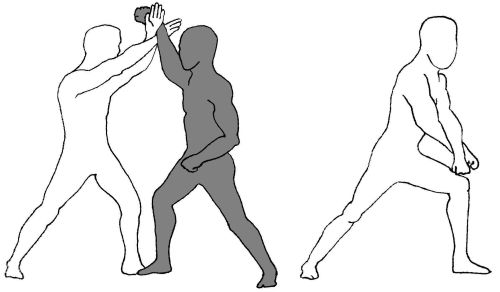
Unfortunately, every forum seems to have at least one blow‑hard who knows a guy, who knew a guy who was attacked and successfully used a scissors block. If you get really lucky, it may work, but the odds are really heavily against you.
Many readers may have seen the “Surviving Edged Weapons” (1988) video. Around the 74 minutes mark there is a simulated attack where the police officer uses a scissors block.
As soon as he is stopped, the attacker drives the point of his knife into one of the cop's forearms and cuts deep along and down the forearm.
If you made the block with the palms towards the attacker, the way it is often taught, the radial and ulnar arteries and nerves will be exposed to this counter. Getting cut on the outside of the forearm is not much fun either.
As an aside, note how often defensive moves in tai chi present the outer surfaces of the forearms towards a foe.
A long bladed weapon may reach past the scissors block and injure the face or head. While it is unlikely an attacker would have a sword bayonet, bread knives or carving knives are possible threats. Such knives are found in any domestic kitchen or hardware store and often feature in domestic violence.
For an armed fighter with a weapon in each hand, such as a pair of sai, the scissors block may work.
Fencing masters such as Joseph Swetnam called this the “double parry” and recommended it as a technique by which the rapier and dagger could deal with powerful longer weapons such as a quarterstaff. Notable is that this is described as a parry, suggesting that it is used to redirect force rather than block/obstruct/oppose it.
Any technique that leaves a target in the path of a weapon has potential for a dangerous failure.
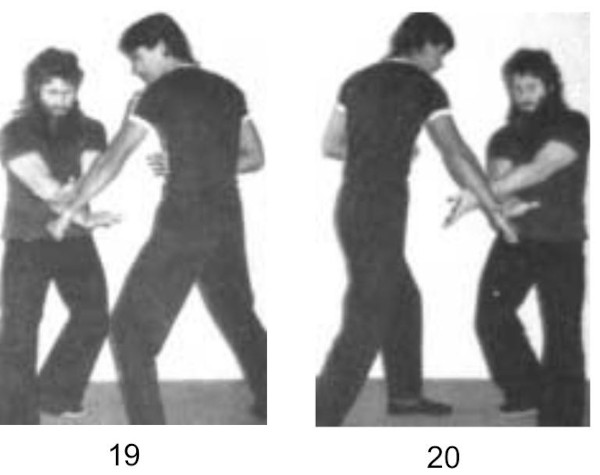
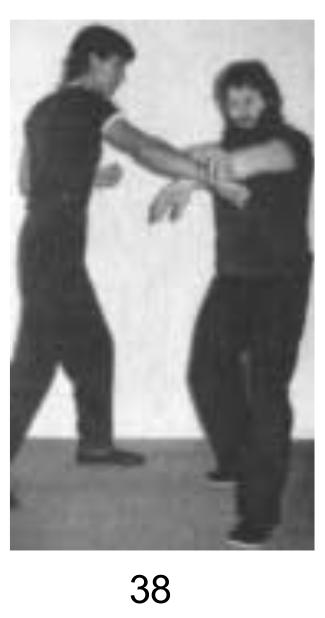
In my last blog, I supplied a link for Erle Montaigue's “How to Use T'ai Chi as a Fighting Art”. The term “scissors block” is used twice in this work. If the associated photos are examined (Nos. 19, 20, 38 and also 11) it will be seen that what is actually being used is a type of two‑handed parry. Waist rotation is being used to divert the force away to the side rather than trying to directly oppose or absorb it.
Rather than countering a vertical downward attack, the two‑handed parry is being used against low lateral attacks. A similar technique could be used against higher level attacks. A low cross hand parry is sometimes termed a “willow tree”.
One of the reasons for using two hands is as a counter to the folding principle. The other hand helps sense or inhibit attempts to slip another attack past a successful parry.
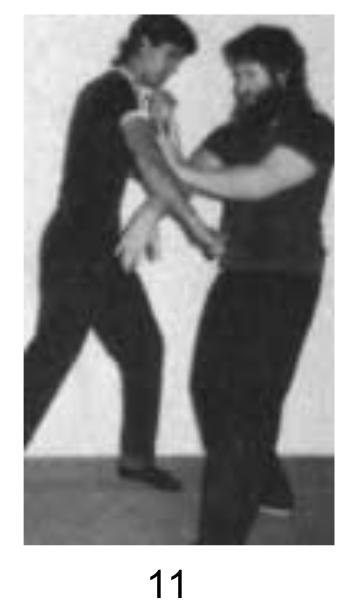
From long har chuan (covered in both my self-defence books) you will have learnt that one hand will often take over a parry to free the other for a more effective counter‑attack. This is facilitated if both hands are in close proximity when the initial defence is made.
With this in mind, it will come as no surprise that many tai chi forms have movements where the hands or wrists are crossed.
Both Yang and Wu styles have a movement usually translated as “cross hands”. Alternately, it is called “ten hands” since the Chinese symbol for the number ten is a cross.
The technique commonly called squeeze, press, ghi, ji or chee may also be looked at as a type of crossed hands. Some writers use the term “cross hands” when discussing ghi. Usually one hand is held with the back toward the foe, and the palm of the other hand placed on the wrist.
One of the applications of this technique is to grasp the head, chest or a limb between the two hands, hence the squeeze/press name.
The joined hands may also be used to push or strike when close to the foe. A variation is to place one palm on the back of the other to make a two‑handed palm strike. Erle notes the press attack can either be a powerful pushing movement or it can be a snapping downward attack.
Yet another variation uses one forearm to ward‑off (peng/p'eng) the foe's attack or body. The rear palm is placed on the forearm and body motion used to unbalance or strike the foe.
The next example is taken from “Wu Style Taijiquan” by Wang Peisheng and Zeng Weiqi.
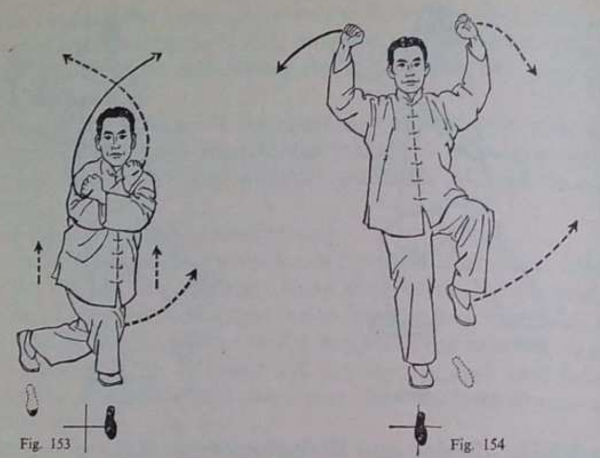
Tai chi moves can often appear very abstract. In this technique, the fighter crosses his hands while apparently allowing one leg to cross behind the other. At first glance, this seems a questionable and potentially unstable move.
When seen in context, we see the twisting turn and drop to the right avoids and aborts the attacker's attempt to kick with his right foot. The motion further unbalances the attacker to fall to his left.
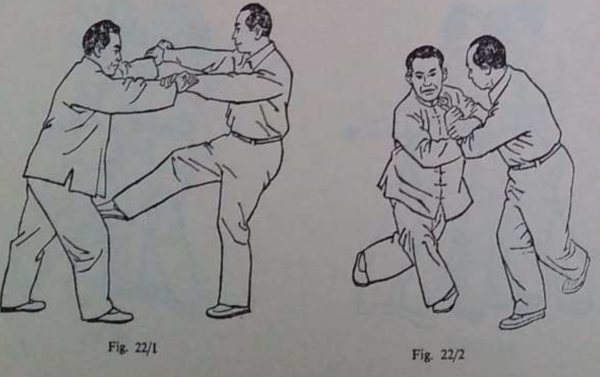
The twisting and dropping action has acted like a spring being compressed, allowing the tai chi fighter to explode upwards and knee or kick his unbalanced attacker.
Crossing the hands puts them in a position from where they can be thrown outwards for balance, or as an alternate or follow-up means to strike.
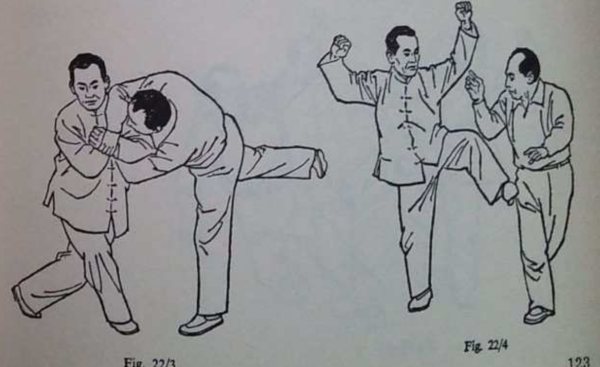
For a casual-looking ready stance, place one hand over the other at around belt-buckle height. From this position a variety of defensive or counter-offensive moves can be made.
Weapons
Many of the techniques described above may be used if you are only wielding a single weapon.
If you are using a baseball bat or hiking staff, you will most likely hold it like a katana with both hands. The weapon may be wielded to defend either side.
If using a weapon with less grip area, such as a knife or baton, it may seem that you unarmed side is less defended. The solution is to bring the weapon to the same central location that a longer weapon would be used from. The unarmed hand is brought up to around the opposite shoulder to defend the chest and throat area. The Filipino martial arts refer to this as the “live hand”.
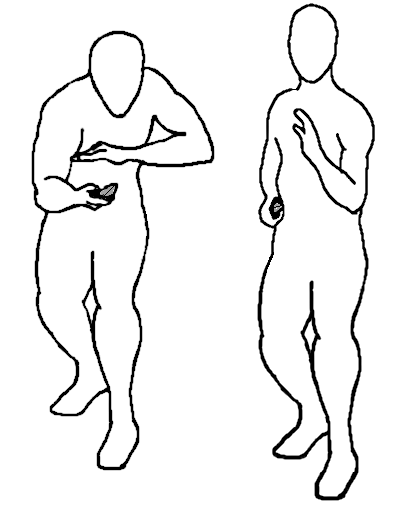
With a little thought, it can be seen that the unarmed hand may be brought forward to assist the armed hand in several of the two‑hand defensive and counter‑attacking techniques already suggested for unarmed use.
Essentially, you have created a posture where your inside gate is close. You keep your inside gate towards the enemy so that you may use either hand in defence or attack.